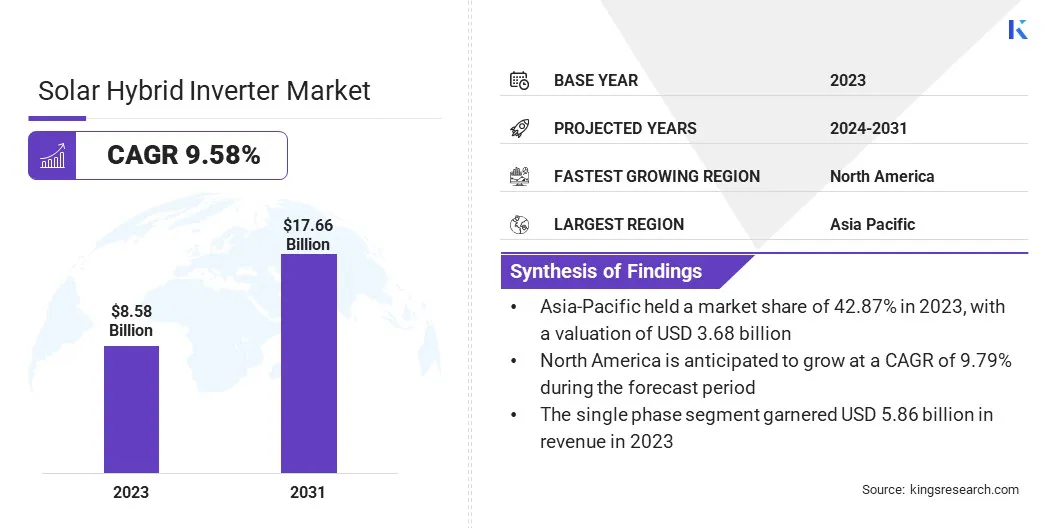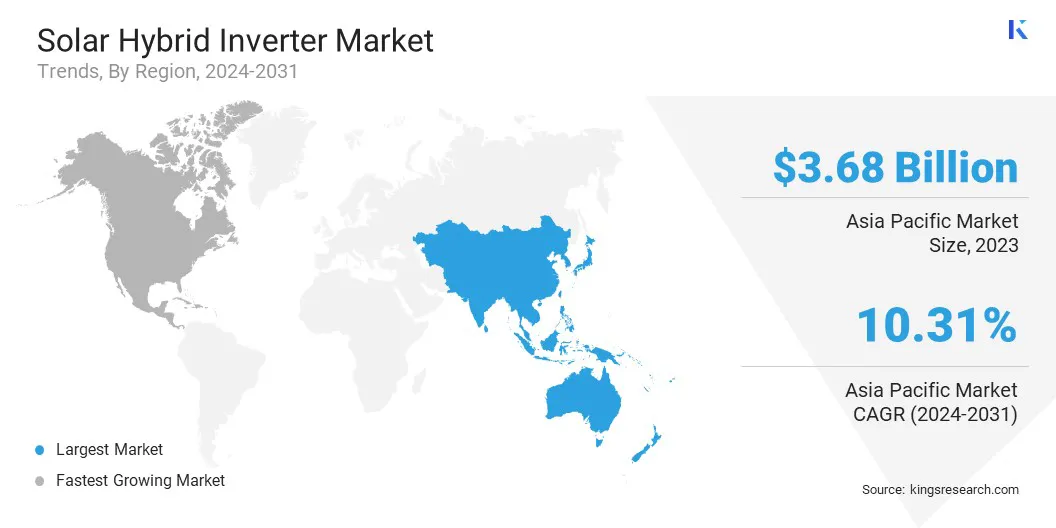Solar Hybrid Inverter Market Size
The global Solar Hybrid Inverter Market size was valued at USD 8.58 billion in 2023 and is projected to grow from USD 9.31 billion in 2024 to USD 17.66 billion by 2031, exhibiting a CAGR of 9.58% during the forecast period. The increasing demand for renewable energy solutions and government incentives are driving the growth of the market.
In the scope of work, the report includes products offered by companies such as Delta Electronics, Inc., Fronius International GmbH, Havells India Ltd., Huawei Technologies Co., Ltd., Phocos, Redback Technologies, Schneider Electric, SMA Solar Technology AG, Voltronic Power Technology Corp., TABUCHI ELECTRIC CO.,LTD., and others.
The solar hybrid inverter market is growing significantly due to the increasing demand for renewable energy solutions and the pressing need to reduce carbon emissions. Government incentives and subsidies for solar power installations are contributing to this growth, prompting both residential and commercial users to adopt solar hybrid inverters.
The rising cost of electricity from traditional sources further propels the shift toward solar energy. Technological advancements in inverter efficiency and energy storage capabilities further support market growth. Additionally, the growing awareness regarding environmental issues and the surging demand for energy independence are leading to the widespread adoption of solar hybrid inverters across various sectors.
- According to the U.S. Chamber of Commerce, in 2023, several US states experienced notable changes in electricity prices. The Northeastern states and California saw significant price increases, with some areas exceeding 19%. Moreover, states such as Louisiana and North Dakota saw moderate price reductions. Despite a slight decrease in its electricity costs, Hawaii maintained the highest overall electricity expenses.
The solar hybrid inverter market is experiencing robust growth due to the combined benefits offered by solar and battery storage systems. Solar hybrid inverters integrate solar energy with other power sources, optimizing energy usage and providing a reliable power supply. These inverters are increasingly being adopted in residential, commercial, and industrial applications as a result of their ability to manage energy from multiple sources efficiently.
The market is characterized by innovations in inverter technology, including enhanced efficiency, improved grid stability, and advanced monitoring capabilities. Major players are investing heavily in research and development to offer cost-effective and efficient hybrid inverter solutions, in response to the rising demand for sustainable energy alternatives.
A solar hybrid inverter is a device that combines the functions of a solar inverter and a battery inverter into one unit, allowing for the integration of solar power with energy storage. These inverters convert direct current (DC) from solar panels into alternating current (AC) for household or business use while simultaneously managing energy storage systems.
They can operate in grid-tied, off-grid, or hybrid modes, providing flexibility in energy management. Solar hybrid inverters optimize the use of solar energy, reduce dependence on the grid, and ensure a consistent power supply even during outages. Their ability to manage and store energy makes them crucial components in modern renewable energy systems.

Analyst’s Review
Manufacturers in the market are actively focusing on enhancing product efficiency and reliability. Recent innovations include advancements in energy storage capabilities and improvements in grid stability functions. This involves optimizing the integration of solar power with battery storage systems to ensure uninterrupted energy supply.
To ensure sustained market growth, manufacturers are advised to prioritize cost reduction strategies and advancements in battery technology. Collaborations with solar panel manufacturers and energy storage providers further facilitates comprehensive solutions for consumers.
- In April 2024, IB Solar, a solar PV modules manufacturer based in Noida, partnered with INVT Solar to open a service center at IB Solar’s Noida premises. This strategic move aimed to strengthen its presence in the solar inverter market and enhance customer service. INVT, renowned for its advanced technology in solar inverters, collaborated with IB Solar to broaden product offerings. The new service center in Noida caters to the growing regional demand, providing technical support, repairs, and maintenance services by INVT-trained professionals, ensuring efficient customer service.
Solar Hybrid Inverter Market Growth Factors
The increasing emphasis on renewable energy is reshaping the solar hybrid inverter market landscape. Governments around the world are implementing policies and offering incentives to promote the adoption of clean energy solutions. Solar hybrid inverters are gaining immense popularity due to their efficiency in integrating solar power with energy storage systems, thereby providing a reliable and sustainable energy source.
The need for energy independence and the rising cost of traditional electricity are further propelling market growth. Innovations in technology are continuously enhancing the performance and affordability of these inverters, making them more accessible to a broader range of consumers. The ongoing shift toward greener energy sources is a significant factor fueling the demand for solar hybrid inverters.
The high initial investment required for installation poses a major challenge to market development, thereby deterring potential consumers. The cost associated with purchasing and installing solar panels, inverters, and energy storage systems is often prohibitive for many consumers. To overcome this challenge, financing options and government subsidies play a crucial role. Offering flexible payment plans, loans, and leasing options makes solar hybrid systems more affordable.
Additionally, government incentives such as tax credits and rebates significantly reduce the financial burden on consumers. Increasing awareness regarding the long-term cost savings and environmental benefits of solar hybrid inverters further promotes their adoption, despite the initial expense.
Solar Hybrid Inverter Market Trends
The rising demand for energy storage solutions is stimulating the expansion of the market. The increasing deployment of renewable energy sources is highlighting the growing need for efficient energy storage to ensure a stable and reliable power supply.
Solar hybrid inverters, which integrate solar power with battery storage, meet this demand by providing continuous energy availability, even during grid outages or periods of low sunlight. This ability to store and manage energy effectively is appealing to both residential and commercial users, thereby contributing to the growth of the market. Continuous advancements in battery technology and decreasing costs are further enhancing the attractiveness of solar hybrid inverters, thereby propelling market growth.
The increasing focus on grid stability and resilience is another notable trend in the solar hybrid inverter market. As the integration of renewable energy sources into the grid increases, ensuring a stable and reliable power supply becomes crucial. Solar hybrid inverters are being designed to support grid stability by providing features such as grid-forming and grid-supportive capabilities.
These inverters help manage voltage and frequency fluctuations, thereby enhancing the stability of the grid. Additionally, the ability of solar hybrid inverters to operate in island mode during grid outages enhances energy security. This trend is fostering the development of more sophisticated and resilient inverter technologies, thereby supporting the broader adoption of renewable energy systems.
Segmentation Analysis
The global market is segmented based on product, end-user, and geography.
By Product
Based on product, the market is categorized into single-phase and three-phase. The single phase segment led the solar hybrid inverter market in 2023, reaching a valuation of USD 5.86 billion. The segment is expanding due to its widespread use in residential and light commercial applications. Single-phase solar hybrid inverters are cost-effective and easier to install compared to their three-phase counterparts.
They are ideal for smaller energy loads, which makes them highly suitable for households and small businesses. The increasing adoption of solar energy in residential areas is fueling the demand for single-phase inverters. Their efficiency in managing lower power requirements and their compatibility with existing residential electrical systems contribute significantly to their market dominance.
By End-User
Based on end-user, the solar hybrid inverter market is classified into residential and commercial. The residential segment is likely to witness significant growth at a CAGR of 9.90% through the forecast period (2024-2031), largely attributed to rising awareness of renewable energy benefits and the pressing need for energy independence among homeowners.
Government incentives and subsidies for residential solar installations are actively promoting their adoption. Technological advancements are making solar hybrid inverters more affordable and efficient, thereby attracting more residential users. Additionally, the residential sector's potential for energy savings and the increasing popularity of home energy storage systems are supporting the expansion of the segment.
Solar Hybrid Inverter Market Regional Analysis
Based on region, the global market is classified into North America, Europe, Asia Pacific, MEA, and Latin America.

Asia-Pacific solar hybrid inverter market share stood around 42.87% in 2023 in the global market, with a valuation of USD 3.68 billion. This notable growth is fostered by rapid industrialization and urbanization, which increase the demand for reliable and sustainable energy solutions.
Countries such as China, India, and Japan are investing heavily in renewable energy infrastructure, supported by favorable government policies and subsidies. The region's abundant solar resources and the growing need to reduce dependence on fossil fuels are further boosting regional market growth.
Additionally, increasing awareness regarding environmental issues and the economic benefits of solar energy are promoting its widespread adoption, thereby aiding regional market expansion.
North America is poised to experience significant growth at a CAGR of 9.79% over the forecast period, primarily fostered by strong governmental support and favorable regulatory frameworks that promote renewable energy adoption. The increasing focus on reducing carbon emissions and achieving energy independence is leading to increased demand for solar hybrid inverters.
Technological advancements and decreasing costs of solar and energy storage systems are making these solutions more accessible. The residential sector is particularly benefiting from incentives such as tax credits and rebates, which are encouraging an increasing number of homeowners to invest in solar hybrid systems.
Competitive Landscape
The global solar hybrid inverter market report will provide valuable insight with an emphasis on the fragmented nature of the industry. Prominent players are focusing on several key business strategies such as partnerships, mergers and acquisitions, product innovations, and joint ventures to expand their product portfolio and increase their market shares across different regions.
Manufacturers are adopting a range of strategic initiatives, including investments in R&D activities, the establishment of new manufacturing facilities, and supply chain optimization, to strengthen their market standing.
List of Key Companies in Solar Hybrid Inverter Market
Key Industry Developments
- December 2023 (Launch): SMA unveiled a versatile PV and storage solution for residential energy needs in Munich. This launch featured the 1-phase Sunny Boy Smart Energy inverter paired with the SMA Home Storage battery, emphasizing high performance and rapid battery charging capabilities. Designed for flexibility in various scenarios, it supported up to four batteries and integrated seamlessly with existing SMA Home Energy Solutions. It included multiple MPP trackers and expandable backup options, ensuring optimal solar utilization, even in shaded areas, and provided a reliable energy supply during grid outages.
- June 2023 (Acquisition): Delta Electronics acquired TB&C Group, a German manufacturer of advanced automotive components for electric vehicles, for $155.7 million. This move expands Delta's EV product offerings and strengthens its battery management systems capabilities.
The global solar hybrid inverter market is segmented as:
By Product
By End-User
By Region
- North America
- Europe
- France
- U.K.
- Spain
- Germany
- Italy
- Russia
- Rest of Europe
- Asia-Pacific
- China
- Japan
- India
- South Korea
- Rest of Asia-Pacific
- Middle East & Africa
- GCC
- North Africa
- South Africa
- Rest of Middle East & Africa
- Latin America
- Brazil
- Argentina
- Rest of Latin America


